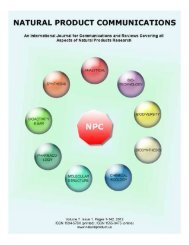This Issue is Dedicated to the Memory of Professor Ivano Morelli
This Issue is Dedicated to the Memory of Professor Ivano Morelli
This Issue is Dedicated to the Memory of Professor Ivano Morelli
You also want an ePaper? Increase the reach of your titles
YUMPU automatically turns print PDFs into web optimized ePapers that Google loves.
1112 Natural Product Communications Vol. 1 (12) 2006 Bilia et al.<br />
investigations <strong>is</strong> related <strong>to</strong> <strong>the</strong> possibility for<br />
populations in endemic areas with ei<strong>the</strong>r scarce or no<br />
access <strong>to</strong> modern medicines or medical services <strong>to</strong><br />
cultivate selected cultivars <strong>of</strong> A. annua and prepare<br />
ei<strong>the</strong>r teas or decoctions from <strong>the</strong> plant material,<br />
achieving a positive effect in <strong>the</strong> treatment <strong>of</strong><br />
malaria.<br />
An herbal tea prepared from a selected cultivar <strong>of</strong><br />
A. annua with a high content <strong>of</strong> artem<strong>is</strong>inin (0.58%<br />
w/w dried herb) was evaluated in malaria patients in<br />
<strong>the</strong> Republic <strong>of</strong> Congo [9]. The dose was according<br />
<strong>to</strong> <strong>the</strong> recommendations <strong>of</strong> <strong>the</strong> Chinese<br />
Pharmacopoeia (5 g herbal drug/day for five days)<br />
and <strong>the</strong> extraction process was investigated in order<br />
<strong>to</strong> have <strong>the</strong> maximum extraction efficiency. It was<br />
proved that it <strong>is</strong> better <strong>to</strong> make an infusion ra<strong>the</strong>r than<br />
a short decoction (kept boiling for five minutes) in<br />
order <strong>to</strong> obtain <strong>the</strong> maximum extraction efficiency <strong>of</strong><br />
more than 40%. In <strong>the</strong> study, about 90.9% <strong>of</strong> patients<br />
reported complete d<strong>is</strong>appearance <strong>of</strong> malaria<br />
symp<strong>to</strong>ms within <strong>the</strong> course <strong>of</strong> <strong>the</strong> treatment and it<br />
was proposed that <strong>the</strong> bioavailability <strong>of</strong> artem<strong>is</strong>inin<br />
from <strong>the</strong> tea preparations may exceed that from pure<br />
artem<strong>is</strong>inin tablets [9].<br />
Two additional interesting papers regarding clinical<br />
studies using traditional preparations appeared almost<br />
contemporarily in 2004. In <strong>the</strong> first investigation<br />
[10], <strong>the</strong> patients received 1 L <strong>of</strong> preparation from 9 g<br />
leaves <strong>of</strong> a special cultivar <strong>of</strong> A. annua containing<br />
1.39% artem<strong>is</strong>inin, which resulted in a content <strong>of</strong><br />
94.5 mg/L artem<strong>is</strong>inin, admin<strong>is</strong>tered in five doses <strong>of</strong><br />
200 mL each per day. Even if <strong>the</strong> given dose <strong>of</strong><br />
artem<strong>is</strong>inin was only 19% <strong>of</strong> <strong>the</strong> usual daily dose <strong>of</strong><br />
artem<strong>is</strong>inin in adults [11], peak plasma levels were<br />
240±75ng/mL artem<strong>is</strong>inin, approximately 40% <strong>of</strong> <strong>the</strong><br />
peak concentrations reported after intake <strong>of</strong> 500 mg<br />
artem<strong>is</strong>inin in <strong>the</strong> form <strong>of</strong> capsules. The data<br />
indicated that artem<strong>is</strong>inin was absorbed faster from<br />
herbal tea preparations than from oral solid dosage<br />
forms, but <strong>the</strong> bioavailability was similar [10]. The<br />
o<strong>the</strong>r study that appeared in 2004 used an herbal<br />
drug containing 1.4% artem<strong>is</strong>inin and <strong>the</strong> infusions<br />
(5 or 9 g/herb /L; artem<strong>is</strong>inin content 47 and 94<br />
mg/L, respectively) were admin<strong>is</strong>tered divided in<strong>to</strong><br />
four doses <strong>of</strong> 250 mL each. Even if <strong>the</strong>re were a<br />
higher rate <strong>of</strong> recrudescence, most <strong>of</strong> <strong>the</strong> reported<br />
malaria symp<strong>to</strong>ms ei<strong>the</strong>r improved or resolved within<br />
three days after initiation <strong>of</strong> <strong>the</strong>rapy, as expected for<br />
ei<strong>the</strong>r an artem<strong>is</strong>inin or quinine treatment [12]. All<br />
<strong>the</strong>se studies have pointed out that <strong>the</strong> presence <strong>of</strong><br />
flavonoids in <strong>the</strong> phy<strong>to</strong>complex can enhance ei<strong>the</strong>r<br />
<strong>the</strong> bioavailability or <strong>the</strong> activity <strong>of</strong> artem<strong>is</strong>inin.<br />
Thus, experimental evidence from in vitro studies<br />
suggests that some flavonoids may enhance <strong>the</strong><br />
action <strong>of</strong> artem<strong>is</strong>inin against P. falciparum [13]. In<br />
an attempt <strong>to</strong> find an optimal extraction method for<br />
both artem<strong>is</strong>inin and flavonoids, we have reported <strong>the</strong><br />
best recovery with n-hexane <strong>to</strong> obtain complete<br />
extraction <strong>of</strong> artem<strong>is</strong>inin and most <strong>of</strong> <strong>the</strong> flavonoids<br />
[14].<br />
The aim <strong>of</strong> <strong>the</strong> present study was <strong>to</strong> analyze <strong>the</strong><br />
qualitative and quantitative composition <strong>of</strong> different<br />
extracts <strong>of</strong> <strong>the</strong> aerial parts <strong>of</strong> a cultivar <strong>of</strong> A. annua<br />
(0.52% artem<strong>is</strong>inin) selected by <strong>the</strong> University<br />
<strong>of</strong> Campinas. The investigated extraction methods<br />
were several techniques <strong>of</strong> infusion and decoction<br />
Sample<br />
Table 1: Artem<strong>is</strong>inin and flavonoid contents <strong>of</strong> tincture preparations (T40: 40% v/v; T60: 60% v/v).<br />
artem<strong>is</strong>inin %<br />
in lyophilized material<br />
extraction<br />
efficiency (%)<br />
flavonoids %<br />
in lyophilized material<br />
extraction<br />
efficiency (%)<br />
artem<strong>is</strong>inin %<br />
flavonoids %<br />
T40 27 0.75 26 41.1 2.64 15.7<br />
T60 41 1.08 40 83.8 3.52 29.5<br />
Sample<br />
artem<strong>is</strong>inin %<br />
in lyophilized material<br />
Table 2: Artem<strong>is</strong>inin and flavonoid contents <strong>of</strong> infusion and decoction preparations.<br />
extraction efficiency (%) flavonoids %<br />
in lyophilized material<br />
extraction efficiency (%)<br />
I1 0.72 30.4 5.38 5.61<br />
I2 0.68 27.4 3.24 5.41<br />
I3 0.80 57.5 5.18 8.17<br />
D1 0.68 30.2 3.28 5.34<br />
D2 0.81 35.9 6.18 9.93<br />
M 0.61 41.0 4.89 7.66<br />
I1: sample extracted with 1 L <strong>of</strong> boiling water, left <strong>to</strong> cool, filtered and lyophilized; I2: sample extracted with 1 L <strong>of</strong> boiling water, covered, left <strong>to</strong> cool, filtered<br />
and lyophilized; I3: sample extracted with 1 L <strong>of</strong> boiling water, left <strong>to</strong> cool for 15 min, filtered and lyophilized; D1: sample extracted with 1 L <strong>of</strong> boiling water,<br />
kept boiling for 5 min, left <strong>to</strong> cool, filtered and lyophilized;D2: sample extracted with 1 L <strong>of</strong> boiling water, kept boiling for 5 min, immediately filtered and<br />
lyophilized; M: sample treated with 1 L <strong>of</strong> water, kept boiling for 5 min with a microwave oven, left <strong>to</strong> cool, filtered and lyophilized.







